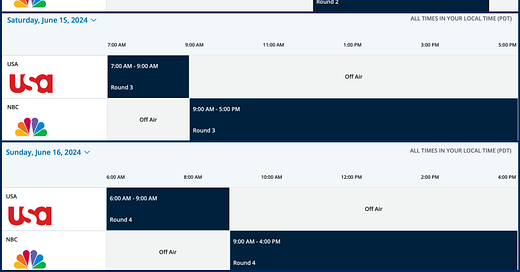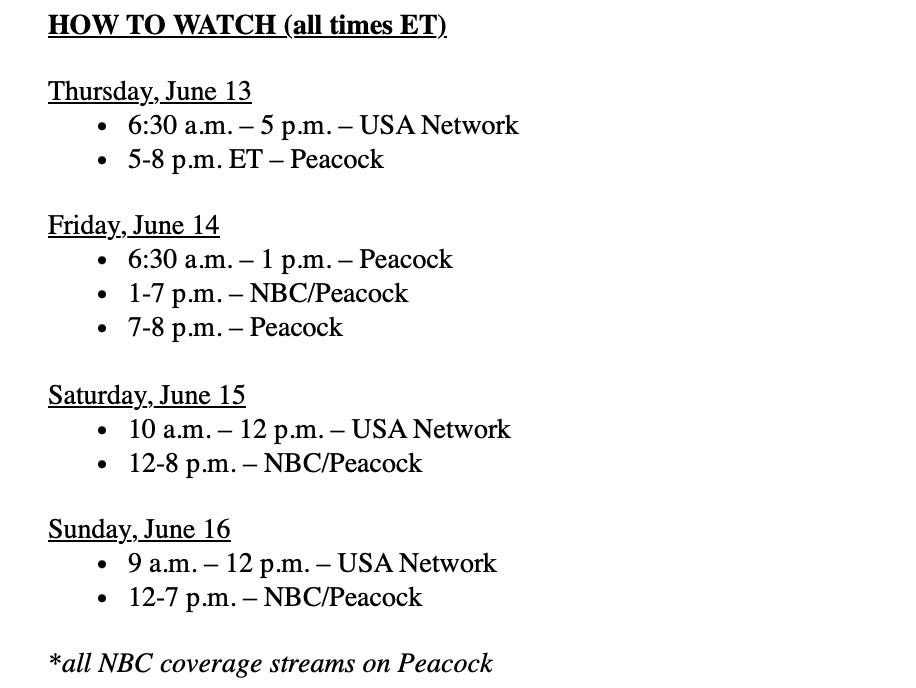NBC Lays Out U.S. Open Coverage Plans
A new weekday twist, two more minutes of golf per hour, and drones that won't bother Bobby Mac are among the 2024 U.S. Open telecast highlights.
Get ready to shuffle!
It’s not entirely apparent why NBC/USA/Peacock designed the U.S. Open broadcast schedule this way (above). You can almost guarantee it had little to do with viewers or their partners at the USGA. Instead, follow the money: company priorities (Kelly Clarkson, NASCAR, Chicago Fire reruns) and Golf Channel’s diminished reach have led to a different weekday approach for the 2024 U.S. Open.
The USGA believes this year’s scheduling reduces switching between channels compared to recent years on the East Coast. The organization, which is in year nine of its current rights deal, points to more over-the-air free viewing than any other major championship. Whether that’s any consolation to viewers
The USGA and NBC broke the major television mold in their first non-ABC contract by agreeing with the pre-Comcast brass to introduce a Thursday-Friday window. The effect of having rounds one and two on NBC made the event bigger and promoted the weekend.
This year NBC will morph its contractually obligated weekday coverage into one block Friday while USA Network hosts all of Thursday coverage. This allows USA to show two hours of NASCAR Friday surrounded by some only the best Chicago Fire reruns. More important to the bottom line, only one day of Kelly Clarkson’s NBCUniversal-syndicated show and Access Daily with Mario and Kit will be interrupted by U.S. Open coverage.
Meanwhile, dated carriage agreements are continuing to create headaches for both cable and streaming-only viewers. It’s almost beyond comprehension this many years into the creation of Peacock—where NBC hopes to everyone eventually—that ways have not been negotiated to make finding and watching the coverage just a bit easier.
Here is the schedule in fine print:
Cordcutters are shut out from watching Thursday coverage on USA Network and are relegated to three hours of Peacock in the evening.
On Friday, cutters have exclusivity over the USA cable subscriber from 6:30 to 1 p.m. ET. Then every streamer can watch from 1-7 p.m. before a final hour is exclusive to Peacock subscribers.
The weekend coverage initially shuts out cordcutters duringg the opening two hours on USA before the multi-hour shows on NBC and Peacock.
In contrast, to Sky Sports’ coverage consisting of…Sky.
And Sky Sports’ Main Event channel (except Friday):
The USGA’s app and website will have coverage. However, tablet users will likely want to access the streams via the web unless a last-minute update allows for full-screen viewing.
As for the actual coverage, NBC Sports did not put technology details in writing but during the old-school conference call where coordinating producer Tommy Roy’s line dropped three times, bells and whistles were touted as was the effort to get more shots shown.
NBC Executive Producer Sam Flood discussed the “four-wide” announcing concept during the call and explained the thinking.
“We’ve gone to this odd-even method where there’s a play-by-play paired with an analyst,” Flood said. “So, for the prime hours from the U.S. Open, Dan is pairing with Brandel, and Mike Tirico is pairing with Brad Faxon. That system has worked very well, the concept being that Dan and Mike take care of context and what is going on on the course, giving historical perspective, and then the whys of why the golfer is being successful or what they’re thinking about on the shot gets handled by the analysts.”
Isn’t that how it’s always been done, only now viewers are subjected to more voices? Or is this about NBC finding a creative way to mask an unwillingness to pay big money for just one analyst?
Flood touted the effort to get viewers an additional two minutes per hour of coverage, estimated to be about five more shots an hour (or two more if Patrick Cantlay is part of the coverage window). And Flood checked off almost every modern media buzzword explaining the extra two minutes.
“There are different ways we feel we can engage the audience and build the content that gives those messages, but we have reduced the amount of promo time in the shows and reduced the amount of time we’ll be interrupted by really smartly evaluating everything we do, where it hits, and how it’s integrated into the telecast.”
It’s not yet clear if “really smartly” means they’re just taking longer commercial breaks to make up for taking one away.
Also…






